Kun Shao
Hi-Agent: Hierarchical Vision-Language Agents for Mobile Device Control
Oct 16, 2025Abstract:Building agents that autonomously operate mobile devices has attracted increasing attention. While Vision-Language Models (VLMs) show promise, most existing approaches rely on direct state-to-action mappings, which lack structured reasoning and planning, and thus generalize poorly to novel tasks or unseen UI layouts. We introduce Hi-Agent, a trainable hierarchical vision-language agent for mobile control, featuring a high-level reasoning model and a low-level action model that are jointly optimized. For efficient training, we reformulate multi-step decision-making as a sequence of single-step subgoals and propose a foresight advantage function, which leverages execution feedback from the low-level model to guide high-level optimization. This design alleviates the path explosion issue encountered by Group Relative Policy Optimization (GRPO) in long-horizon tasks and enables stable, critic-free joint training. Hi-Agent achieves a new State-Of-The-Art (SOTA) 87.9% task success rate on the Android-in-the-Wild (AitW) benchmark, significantly outperforming prior methods across three paradigms: prompt-based (AppAgent: 17.7%), supervised (Filtered BC: 54.5%), and reinforcement learning-based (DigiRL: 71.9%). It also demonstrates competitive zero-shot generalization on the ScreenSpot-v2 benchmark. On the more challenging AndroidWorld benchmark, Hi-Agent also scales effectively with larger backbones, showing strong adaptability in high-complexity mobile control scenarios.
PerPilot: Personalizing VLM-based Mobile Agents via Memory and Exploration
Aug 25, 2025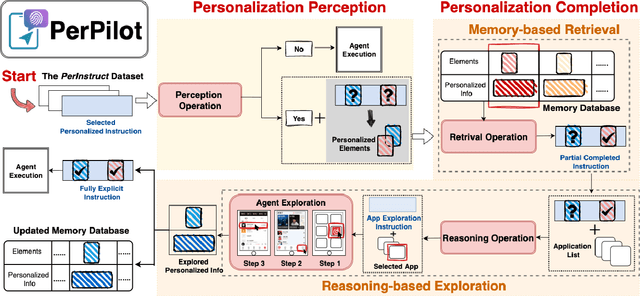

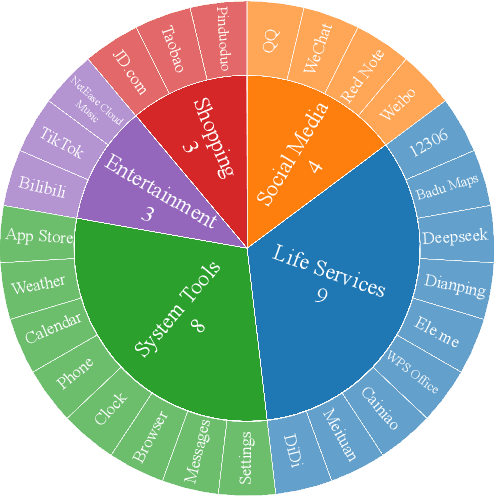
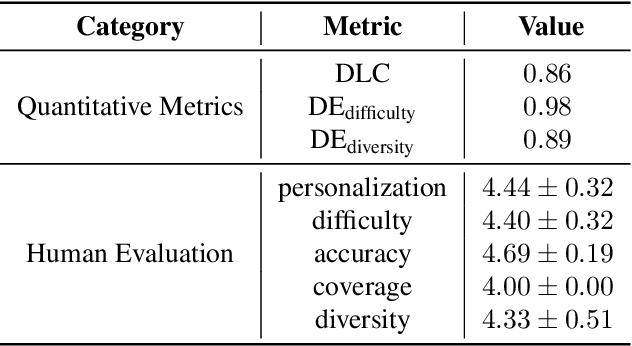
Abstract:Vision language model (VLM)-based mobile agents show great potential for assisting users in performing instruction-driven tasks. However, these agents typically struggle with personalized instructions -- those containing ambiguous, user-specific context -- a challenge that has been largely overlooked in previous research. In this paper, we define personalized instructions and introduce PerInstruct, a novel human-annotated dataset covering diverse personalized instructions across various mobile scenarios. Furthermore, given the limited personalization capabilities of existing mobile agents, we propose PerPilot, a plug-and-play framework powered by large language models (LLMs) that enables mobile agents to autonomously perceive, understand, and execute personalized user instructions. PerPilot identifies personalized elements and autonomously completes instructions via two complementary approaches: memory-based retrieval and reasoning-based exploration. Experimental results demonstrate that PerPilot effectively handles personalized tasks with minimal user intervention and progressively improves its performance with continued use, underscoring the importance of personalization-aware reasoning for next-generation mobile agents. The dataset and code are available at: https://github.com/xinwang-nwpu/PerPilot
Uncertainty-quantified Rollout Policy Adaptation for Unlabelled Cross-domain Temporal Grounding
Aug 08, 2025Abstract:Video Temporal Grounding (TG) aims to temporally locate video segments matching a natural language description (a query) in a long video. While Vision-Language Models (VLMs) are effective at holistic semantic matching, they often struggle with fine-grained temporal localisation. Recently, Group Relative Policy Optimisation (GRPO) reformulates the inference process as a reinforcement learning task, enabling fine-grained grounding and achieving strong in-domain performance. However, GRPO relies on labelled data, making it unsuitable in unlabelled domains. Moreover, because videos are large and expensive to store and process, performing full-scale adaptation introduces prohibitive latency and computational overhead, making it impractical for real-time deployment. To overcome both problems, we introduce a Data-Efficient Unlabelled Cross-domain Temporal Grounding method, from which a model is first trained on a labelled source domain, then adapted to a target domain using only a small number of unlabelled videos from the target domain. This approach eliminates the need for target annotation and keeps both computational and storage overhead low enough to run in real time. Specifically, we introduce. Uncertainty-quantified Rollout Policy Adaptation (URPA) for cross-domain knowledge transfer in learning video temporal grounding without target labels. URPA generates multiple candidate predictions using GRPO rollouts, averages them to form a pseudo label, and estimates confidence from the variance across these rollouts. This confidence then weights the training rewards, guiding the model to focus on reliable supervision. Experiments on three datasets across six cross-domain settings show that URPA generalises well using only a few unlabelled target videos. Codes will be released once published.
SpatialViz-Bench: Automatically Generated Spatial Visualization Reasoning Tasks for MLLMs
Jul 10, 2025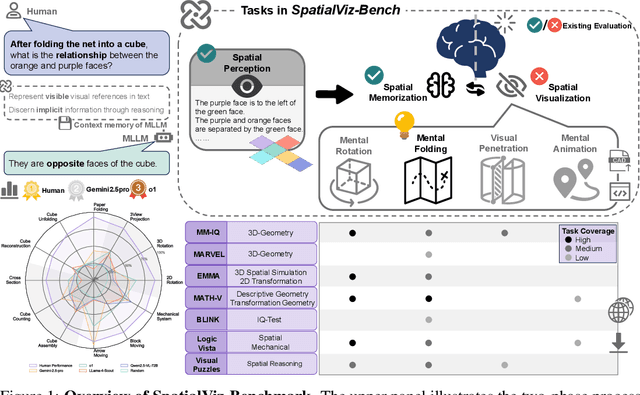
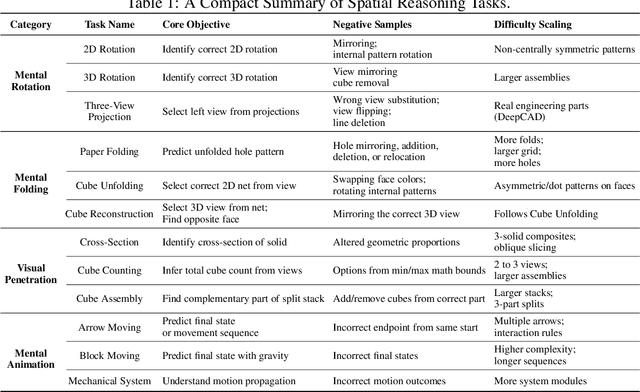
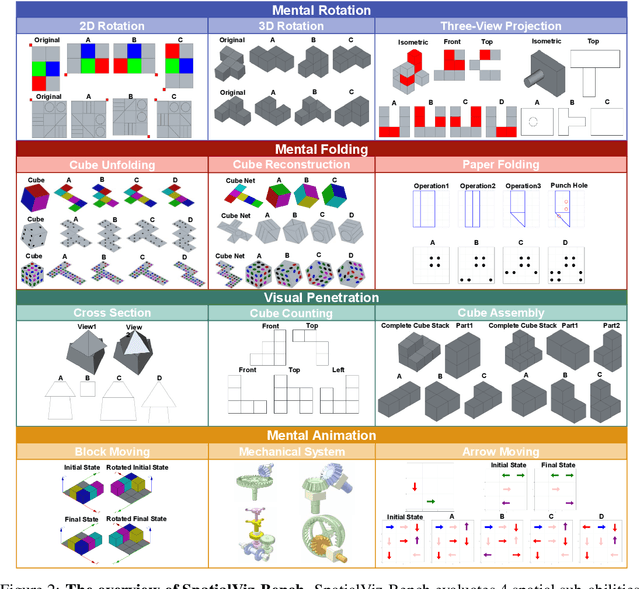
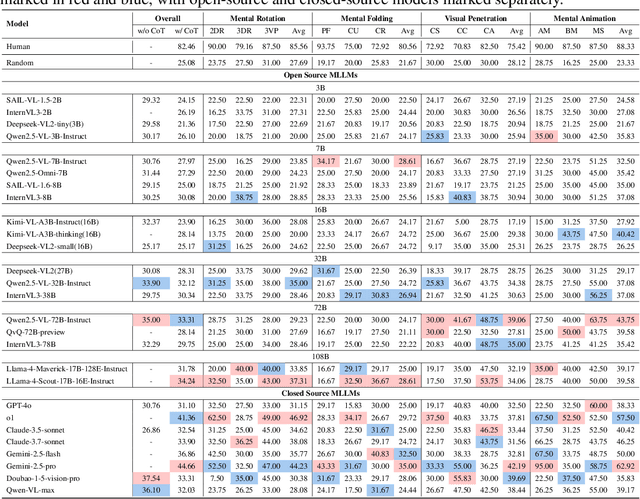
Abstract:Humans can directly imagine and manipulate visual images in their minds, a capability known as spatial visualization. While multi-modal Large Language Models (MLLMs) support imagination-based reasoning, spatial visualization remains insufficiently evaluated, typically embedded within broader mathematical and logical assessments. Existing evaluations often rely on IQ tests or math competitions that may overlap with training data, compromising assessment reliability. To this end, we introduce SpatialViz-Bench, a comprehensive multi-modal benchmark for spatial visualization with 12 tasks across 4 sub-abilities, comprising 1,180 automatically generated problems. Our evaluation of 33 state-of-the-art MLLMs not only reveals wide performance variations and demonstrates the benchmark's strong discriminative power, but also uncovers counter-intuitive findings: models exhibit unexpected behaviors by showing difficulty perception that misaligns with human intuition, displaying dramatic 2D-to-3D performance cliffs, and defaulting to formula derivation despite spatial tasks requiring visualization alone. SpatialVizBench empirically demonstrates that state-of-the-art MLLMs continue to exhibit deficiencies in spatial visualization tasks, thereby addressing a significant lacuna in the field. The benchmark is publicly available.
AgentSwift: Efficient LLM Agent Design via Value-guided Hierarchical Search
Jun 06, 2025Abstract:Large language model (LLM) agents have demonstrated strong capabilities across diverse domains. However, designing high-performing agentic systems remains challenging. Existing agent search methods suffer from three major limitations: (1) an emphasis on optimizing agentic workflows while under-utilizing proven human-designed components such as memory, planning, and tool use; (2) high evaluation costs, as each newly generated agent must be fully evaluated on benchmarks; and (3) inefficient search in large search space. In this work, we introduce a comprehensive framework to address these challenges. First, We propose a hierarchical search space that jointly models agentic workflow and composable functional components, enabling richer agentic system designs. Building on this structured design space, we introduce a predictive value model that estimates agent performance given agentic system and task description, allowing for efficient, low-cost evaluation during the search process. Finally, we present a hierarchical Monte Carlo Tree Search (MCTS) strategy informed by uncertainty to guide the search. Experiments on seven benchmarks, covering embodied, math, web, tool, and game, show that our method achieves an average performance gain of 8.34\% over state-of-the-art baselines and exhibits faster search progress with steeper improvement trajectories. Code repo is available at https://github.com/Ericccc02/AgentSwift.
ViMo: A Generative Visual GUI World Model for App Agent
Apr 15, 2025Abstract:App agents, which autonomously operate mobile Apps through Graphical User Interfaces (GUIs), have gained significant interest in real-world applications. Yet, they often struggle with long-horizon planning, failing to find the optimal actions for complex tasks with longer steps. To address this, world models are used to predict the next GUI observation based on user actions, enabling more effective agent planning. However, existing world models primarily focus on generating only textual descriptions, lacking essential visual details. To fill this gap, we propose ViMo, the first visual world model designed to generate future App observations as images. For the challenge of generating text in image patches, where even minor pixel errors can distort readability, we decompose GUI generation into graphic and text content generation. We propose a novel data representation, the Symbolic Text Representation~(STR) to overlay text content with symbolic placeholders while preserving graphics. With this design, ViMo employs a STR Predictor to predict future GUIs' graphics and a GUI-text Predictor for generating the corresponding text. Moreover, we deploy ViMo to enhance agent-focused tasks by predicting the outcome of different action options. Experiments show ViMo's ability to generate visually plausible and functionally effective GUIs that enable App agents to make more informed decisions.
VideoAgent2: Enhancing the LLM-Based Agent System for Long-Form Video Understanding by Uncertainty-Aware CoT
Apr 06, 2025Abstract:Long video understanding has emerged as an increasingly important yet challenging task in computer vision. Agent-based approaches are gaining popularity for processing long videos, as they can handle extended sequences and integrate various tools to capture fine-grained information. However, existing methods still face several challenges: (1) they often rely solely on the reasoning ability of large language models (LLMs) without dedicated mechanisms to enhance reasoning in long video scenarios; and (2) they remain vulnerable to errors or noise from external tools. To address these issues, we propose a specialized chain-of-thought (CoT) process tailored for long video analysis. Our proposed CoT with plan-adjust mode enables the LLM to incrementally plan and adapt its information-gathering strategy. We further incorporate heuristic uncertainty estimation of both the LLM and external tools to guide the CoT process. This allows the LLM to assess the reliability of newly collected information, refine its collection strategy, and make more robust decisions when synthesizing final answers. Empirical experiments show that our uncertainty-aware CoT effectively mitigates noise from external tools, leading to more reliable outputs. We implement our approach in a system called VideoAgent2, which also includes additional modules such as general context acquisition and specialized tool design. Evaluation on three dedicated long video benchmarks (and their subsets) demonstrates that VideoAgent2 outperforms the previous state-of-the-art agent-based method, VideoAgent, by an average of 13.1% and achieves leading performance among all zero-shot approaches
ThinkBench: Dynamic Out-of-Distribution Evaluation for Robust LLM Reasoning
Feb 22, 2025Abstract:Evaluating large language models (LLMs) poses significant challenges, particularly due to issues of data contamination and the leakage of correct answers. To address these challenges, we introduce ThinkBench, a novel evaluation framework designed to evaluate LLMs' reasoning capability robustly. ThinkBench proposes a dynamic data generation method for constructing out-of-distribution (OOD) datasets and offers an OOD dataset that contains 2,912 samples drawn from reasoning tasks. ThinkBench unifies the evaluation of reasoning models and non-reasoning models. We evaluate 16 LLMs and 4 PRMs under identical experimental conditions and show that most of the LLMs' performance are far from robust and they face a certain level of data leakage. By dynamically generating OOD datasets, ThinkBench effectively provides a reliable evaluation of LLMs and reduces the impact of data contamination.
VSC-RL: Advancing Autonomous Vision-Language Agents with Variational Subgoal-Conditioned Reinforcement Learning
Feb 11, 2025Abstract:State-of-the-art (SOTA) reinforcement learning (RL) methods enable the vision-language agents to learn from interactions with the environment without human supervision. However, they struggle with learning inefficiencies in tackling real-world complex sequential decision-making tasks, especially with sparse reward signals and long-horizon dependencies. To effectively address the issue, we introduce Variational Subgoal-Conditioned RL (VSC-RL), which reformulates the vision-language sequential decision-making task as a variational goal-conditioned RL problem, allowing us to leverage advanced optimization methods to enhance learning efficiency. Specifically, VSC-RL optimizes the SubGoal Evidence Lower BOund (SGC-ELBO), which consists of (a) maximizing the subgoal-conditioned return via RL and (b) minimizing the subgoal-conditioned difference with the reference policy. We theoretically demonstrate that SGC-ELBO is equivalent to the original optimization objective, ensuring improved learning efficiency without sacrificing performance guarantees. Additionally, for real-world complex decision-making tasks, VSC-RL leverages the vision-language model to autonomously decompose the goal into feasible subgoals, enabling efficient learning. Across various benchmarks, including challenging real-world mobile device control tasks, VSC-RL significantly outperforms the SOTA vision-language agents, achieving superior performance and remarkable improvement in learning efficiency.
AppVLM: A Lightweight Vision Language Model for Online App Control
Feb 10, 2025



Abstract:The utilisation of foundation models as smartphone assistants, termed app agents, is a critical research challenge. These agents aim to execute human instructions on smartphones by interpreting textual instructions and performing actions via the device's interface. While promising, current approaches face significant limitations. Methods that use large proprietary models, such as GPT-4o, are computationally expensive, while those that use smaller fine-tuned models often lack adaptability to out-of-distribution tasks. In this work, we introduce AppVLM, a lightweight Vision-Language Model (VLM). First, we fine-tune it offline on the AndroidControl dataset. Then, we refine its policy by collecting data from the AndroidWorld environment and performing further training iterations. Our results indicate that AppVLM achieves the highest action prediction accuracy in offline evaluation on the AndroidControl dataset, compared to all evaluated baselines, and matches GPT-4o in online task completion success rate in the AndroidWorld environment, while being up to ten times faster. This makes AppVLM a practical and efficient solution for real-world deployment.
 Add to Chrome
Add to Chrome Add to Firefox
Add to Firefox Add to Edge
Add to Edge